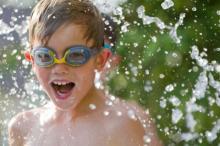
Water is one of the earliest play materials, readily accessible in most areas of the world in the ocean, lakes, rivers, creeks and ponds. Water holds an endless fascination to children who seldom miss opportunities to play in it.
Because most people did not have easy access to the natural sources of water, swimming pools were built. This made water play more available regardless of the geographical location. Indoor plumbing allowed for water play to be moved inside the home, and soon manufacturers were recognizing the value of water play producing bath toys, water guns, and other water toys.1
Pools
Outdoor and indoor swimming pools offer hours of fun for children and adults alike. Pools come in many sizes and designs. Municipal pools are mostly rectangular shaped with varying depths of water and divisions of purpose, such as wading areas for young children, lap swimming areas, and diving depths. Indoor pools are found in homes, hotels, schools, and gyms and are used for personal enjoyment and therapeutic benefits. Large wave-producing pools are popular in water-themed parks.2
Great care must be used to ensure the safety of young children who are attracted to water. However, children often have limited cause and effect thinking ability, are poorly coordinated, and may not be able to swim. Because of the growing awareness of the scope of drownings, many laws and regulations have been implemented for child protection requiring barriers, supervision, and emergency preparation.3
Spray Parks
Children have always loved backyard sprinklers, neighborhood fire hydrants and city fountains in the warm summer weather. Water spray parks provide a great way to cool off in the heat and have become a popular alternative to swimming pools. They offer a less expensive consideration for many municipalities and they can often fit into an existing public park.
Spray parks are designed with unique play areas where water is sprayed from structures or ground sprays and then drained away before it can accumulate. Many of them have waterfalls as well as a variety of spray effects including dumping water, misty sprays, showers, geysers, jets, foam sprays, gushers, sprinklers, streams of water, or bubbles.4 They should be in sunny locations with non-slip surfaces surrounding the spray areas. Children of all ages and abilities can enjoy a spray park.
Water Parks
In recent years water parks that combine features such as water sprays, water slides, lazy rivers, and pools have become very popular. Thrilling, high speed water slides and long twisting slides offer a myriad of ways to enjoy the water. Floating on a tube in a lazy, meandering river is an alternative for those looking for relaxation. Rock climbing walls and cargo nets are challenging for many and combine interactive water play with spray features. Some water parks also offer wave pools and other artificial environments for surfing and body boarding. The trend toward bigger and more elaborate water parks offers increasingly novel innovations in water play.
Water Play in the Classroom
Playing with water has significant value affecting many senses.5 Educators recognize the merit of water play as it can foster physical, social-emotional, and cognitive development by improving motor skills, eye-hand coordination, imaginative and dramatic play, and math and science concepts.6 Some possible mathematical concepts are empty vs. full, shallow vs. deep, and rational counting. Measuring is another skill that uses tools such as measuring cups, tubes, and other containers.7 Science concepts could include sink vs. float, changes of state, displacement, pressure, and motion. It has been observed that children will focus on water activities considerably longer than many other activities in learning situations.8
Water tables used inside the classroom allow children the opportunity to learn to work together in learning activities involving water, and they can make water play accessible to children in wheelchairs. These can be made inexpensively, and there are many commercially manufactured water tables on the market for the classroom. The tables must be carefully maintained for cleanliness to prevent the spread of germs. They should be disinfected daily with bleach solution and filled with fresh water. Learning materials used in the water table should also be cleaned and disinfected.9
- 1. Frost, Joe L., Pei-San Brown, John A. Sutterby, Candra D. Thornton. The Developmental Benefits of Playgrounds. Olney, MD: Association for Childhood Education International, 2004. p. 205-206.
- 2. Perkins, Philip Herald. Swimming Pools. New York, NY: Routledge, 2000. p. 21.
- 3. Frost, Joe L., Sue Wortham, Stuart Reifel. Play and Child Development. Upper Saddle River, NJ: Prentice-Hall, Inc., 2001. pp. 484-487.
- 4. Forrest, Cory, Matthew M. Fraleigh. “Add spray to your play: how to plan aquatic playgrounds that kids will love.” < http://findarticles.com/p/articles/mi_m1145/is_2_39/ai_113756459/ > 19 July 2010.
- 5. Moore, Robin C., Susan M. Goltsman, Daniel S. Iacofano. Play For All Guidelines: Planning, Design and Management of Outdoor Play Settings for All Children, 2nd edition. Berkeley, CA: MIG Communications, 1992. p. 150.
- 6. Milnes, Sheila. “Wonderful Water” Penn State Web-Based Learning Units < http://betterkidcare.psu.edu/AngelUnits/OneHour/WaterPlay/WaterLesson.html > 19 July 2010.
- 7. Op cit., Frost, Brown, Sutterby, Thornton, p. 206.
- 8. Tai, Lolly, Mary Taylor Haque, Ginal K. McLellan, Erin Jordan Knight. Designing Outdoor Environments for Children, Landscaping Schoolyards, Gardens, and Playgrounds. New York, NY: McGraw-Hill, 2006. p. 128.
- 9. “Water play: A key to children's living-learning environment.” KidSource. < http://www.kidsource.com/kidsource/content3/waterplay.t.p.2.html > 19 July 2010.

